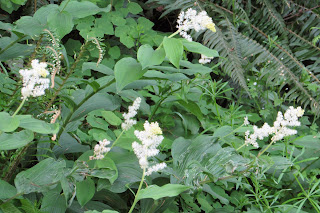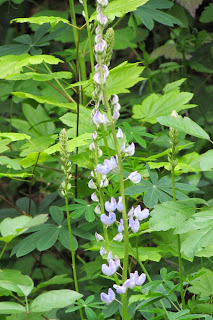I've had The Goode Huswife's "Birds in a Bower" kitted up since September 2011 when I blogged about it, but I've never gotten around to stitching it. Maybe this month I'll start.
After a couple of days of rain, the weather is perfect for a walk, and there is so much to see. I hope you are up for a lengthy ramble.
My theme for this walk was going to be Strictly Wildflowers, but I had to show off the lovely dangling blooms of the Chokecherry (Prunus virginiana). One bank of the Big Creek is lined with tall stands of these impressive shrubs.
It's Camas time (Camassia quamash).
They somewhat resemble Lupin.
So much is in bloom in mid-May: Wood Violets, Larged-leafed Avens (Geum macrophyllum ), Cow's Parsnip, Buttercups, and Camas with two kinds of Vetch.
The Fragrant Fringecup (Tellima grandiflora) has tall flower stalks the blooms will turn from green to red.
I love the flowers of Large False Solomon's Seal (Maianthemum racemosum).
They are worthy of close examination.
The first of the Red Columbine (Aquilegia formosa) are blooming - they depend on hummingbirds as one of their main pollinators.
We have a couple kinds of Lupine, this one has pale soft blue-violet flowers and is the first to bloom.
The bloom is nothing to look at, but the fruit of the Thimbleberry (Rubus parviflorus) is an important source of food for native birds.
I quite like the funky shaggy flowers of the Western Meadowrue (Thalictrum occidentale).
Field Mustard and Forget-me-not type flower I've never been able to identify , and some kind of water loving Buttercup.
Our native tiger lily the Columbia Lily (Lilium columbianum)will bloom in June.
Look - the Nooka Rose (Rosa Nutkana) is blooming in May!
Here's the pale pink flowers of the Meadow Checker-mallow (Sidalcea campestris) growing in a meadow just as its name indicates it should.
These dainty flowers have a long name - the Northern Inside Out Flower (Vancouveria hexandra). They grow in the shade of the forest.
This collage has some of the invasive species that are very much at home - Wild Strawberries Scotch Broom, Vetch and Blackberries.
This is my clump of Pacific Bleeding Heart (Dicentra formosa). I have it in a north-facing flowerbed with other native plants and it is extremely happy.
Among the tall green grass the Pale Flax (Linum bienne) is in bloom. The flowers are hermaphrodite and are pollinated by bees and wasps.
The Oregon Blue Iris (Iris tenax) have peaked early this year. I won't be picking any for Memorial Day.
I do think a meadow with Iris is tough to beat.
And the detail on the petals - the white and yellow flairs are extraordinary.
Sharing the meadow with the Iris are a few plants of Menzie's Larkspur (Delphinium menziesii). Such a deep dark purple!
We've always called these flowers Cat's Ears. The more common name is Tolmie's Mariposa Lily (Calochortus tolmiei). They too grow in the meadow.
We have two kinds of Calochortus growing. The photo on the left shows the Elegant Cat's Ears (Calochortus elegans). The petals are notched and the flower's center has a dark purple rim. The two photos on the right are Tolmie's Mariposa Lily with rounded petals and no purple line in the flower's center. But without close examination the two flowers look alike don't they?
I hope you are not exhausted from our extended walk. Time to put our feet up and have a drink and a rest!





























6 comments:
I always enjoy your garden walks and thank you for educating me on all the names of the flowers :)
Enjoy your day!
Awesome! I like the shade of pink the bleeding heart are.
What a God-kissed meadow you traverse...Really appreciate your
knowledge of the many wild flowers
no longer being seen in our rush
to build malls and parking lots.
Oh how I enjoyed the walk today! I wish I had a meadow full of Iris and other wildflowers.
A wonderful walk with some beautiful flowers. A great combination.
Lovely walk and education on your local plant life, as always. :)
Post a Comment